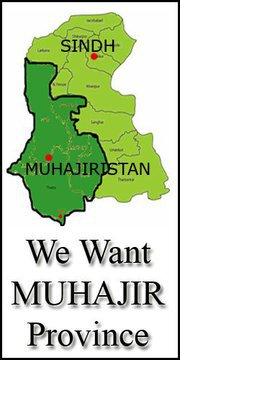Mohajir are peace loving, democratic, liberal, educated and skilled patriotic Pakistani, who firmly believes in non violence, democratic struggle for their rights and to play constitutional role for a separate province. Mohajirs wants their basic rights; they nor want to become master and neither to be slave of any community.
Mohajirs are patriotic Pakistani who believes in the integrity and solidarity of Pakistan. However, it is a universally accepted principle that geographical boundaries of province are not considered sacrosanct. It is imperative that the prevailing sense of deprivation and deliberate denial of legitimate rights is felt intensely amongst Mohajirs. If the sense of deprivation germinating amongst Saraiki’s and Hazarawal community can not be overlooked and the demand of Saraiki province and Hazara province are to be justified and considered natural then it is also not be overlooked the demand of Mohajir province. Because Mohajirs are a separate nation, they have their language, culture, custom and dress. They are living in Sindh province but still not consider as a Sindhi by every government and Sindhi nationalists. Mohajirs are also victimised like Saraiki and Hazara community in every walk of life like higher educational institutes and employment.
It is also bounded duty of a democratic government to take notice of such discontent and if any community demands demarcation and of provincial boundaries which they strongly believe would ensure their due share in their economic, social and cultural development, then to brand it as a crime or treason is not only irrational but despotic.
It is not unusual for states to redemarcate the boundaries of provinces, prefectures, districts etc. for administrative, revenue and demographic considerations. When for the sake of better administration and management, states had to resort to a process of redemarcation of one or more provinces or create a new province from existing one. Such measures were just matters of expediency and common sense and accepted as good management principles – examples being formation of one unit and its subsequent break. Even now balochis, Saraikis and Hazarawall community are demanding their due share, representation in federal government, its services including defence service and for separate province. In the same way, Mohajirs have been subjected to subjugation and deprivation beyond all limits and are now demanding due representation in the establishment and for Mohajir province.
Looking realistically into those demands is the only just and sensible way of dealing with deep rooted discontent. Due to continuous injustice and repression, the such a level that they are left with no option but to demand a separate Mohajir province for their vary survival, without threatening due rights of any other community.
Now, every Mohajir reached this conclusion that Mohajirs are not accepted as “ Son of the Soil” they have no identity, they have no land and they are not allowed to become Chief Minister of Sindh therefore, all Mohajir should unite under the banner of Mohajir Province.
It is not unnatural or harmful to any country in the world to have more provinces or states. This action gives more power and rights to the people. Giving more rights to the people in any country strengthens the federation. Our two immediate neighbours Afghanistan has 34 Provinces, India has 28 states and 7 union territories and United States has 51 states.

